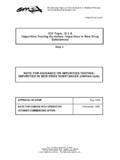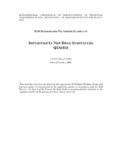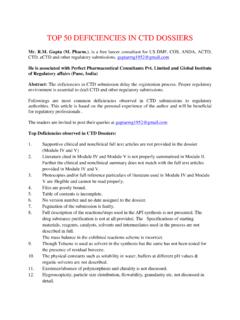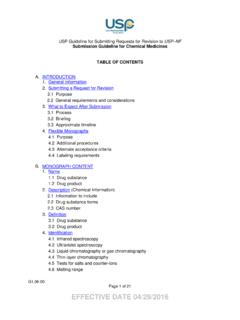Transcription of GUIDANCE FOR INDUSTRY Impurities in Drug …
1 International Journal of Generic DrugsInternational Journal of Generic International Journal365of Generic Drugs e-* 0793 694X US/Canada ISSN 0793 7784 EuroISSN 0793 7822 Pacific RimDraft GuidelinesRevisitedFirst Issued June 1998NO FINAL GUIDE YETI mpurities in drug ANDAsINTRODUCTION raft active drug substance guidancepublished back in June 1998provide, draft recommendations forincluding information in abbreviated newdrug applications (ANDAs) andsupporting drug master files (DMFs) onthe identification and qualification ofimpurities in drug substancesproduced by chemical syntheses forboth monograph and non-monographdrug substances. Impurities in drugsubstances are addressed from twoperspectives: CHEMISTRY ASPECTS including classification and identificationof Impurities , generating analyticalreports, setting specifications, and abrief discussion of analytical procedures SAFETY ASPECTS including comparative studies andgenotoxocity & CompareInnovator DrugImpuritiesSpecific GUIDANCE is provided for:l Qualifying Impurities found in the drugsubstance used for the ANDA via acomparison with Impurities found in therelated USP monograph, scientificliterature, or innovator materiall Qualifying Impurities found at higherlevels in the drug substance used forthe ANDA than found in the related USPmonograph, scientific literature, orinnovator material.
2 L Qualifying Impurities in the drugsubstance used for the ANDA that arenot found in the related USPmonograph, scientific literature, orinnovator material;l Threshold levels, below whichqualification is not June 1998 FDA draft GUIDANCE isnot applicable to the following classes:- biological and biotechnological peptides, oligonucleotides radio-pharmaceuticals fermentation & derived semi-syntheticproducts herbal products crude products of animal/plant recommendations in this guidanceare effective upon publication of the finalguidance (sometime in 2000) andshould be followed in preparing newapplications and supplements forchanges in drug substance synthesis , if the information in a drugsubstance DMF cited in such an ANDAor ANDA supplement has beenreviewed prior to the publication of thefinal GUIDANCE , this GUIDANCE does GUIDANCE is intended to be acompanion document to theInternational Conference on Q3 AHarmonization (ICH)
3 FOR INDUSTRYI nternational Journal of Generic DrugsInternational Journal of Generic International Journal366of Generic Drugs e-* 0793 694X US/Canada ISSN 0793 7784 EuroISSN 0793 7822 Pacific Rim10 'RULES TO REMEMBER'Rule - Evaluate the RLDimpurity profile ( get a baseline).Rule Treat with CAUTIONor REJECT a vendor profileHIGHER than the LOOK at impurityprofiles in the majorpharmacopoeia (USP / BP / JP)and compare with vendor'sdedicated synthesis (comparingprofiles is important)Rule 'Approved vendors'may have unique Impurities due tothe purifying for these 'specifiedimpurities' in the activeschromatograms ( "Stress theActive material").Rule Unknown impuritiesmust not exceed (if they do,go back to active vendor to cleanup material).
4 Rule Organic Impurities arethe main focus in impuritiy profiles(Note: residual solvents have thereown guideline and limits).Rule Do get the DMFholder to state the 'specificimpurities' and the potentialimpurities ( those impuritieswhich do arise and those whichcan arise).Rule Always stress theactive in-house to see whichimpurities do In drug development,if the active has an unknown> - and it can not be reduced- Look for an alternative supplywith a better REMEMBER anunknown impurity close to grow to > on stability(ageing). There's no such conceptas a safe unknown > Impurities in New DrugSubstances.[The ICH Q3A 27 GUIDANCE was published in theFederal Register on January 4, 1996 (61 FR 371),and issued as a Center for drug Evaluation andResearch (CDER) GUIDANCE .]
5 ]Evaluate thisdraft guidanceside-by-sidewith Q3 AICH Q3A provides recommendations for(1) inclusion of information regardingspecified Impurities in certain new drugapplications (NDAs) (identified andunidentified Impurities in new drugsubstance specifications) and,(2) qualification of Impurities (theprocess of acquiring and evaluatingdata that establishes the biologicalsafety of individual Impurities or a givenimpurity profile at the level(s) specified).International Journal of Generic DrugsInternational Journal of Generic International Journal367of Generic Drugs e-* 0793 694X US/Canada ISSN 0793 7784 EuroISSN 0793 7822 Pacific RimGeneric drugs are not covered by ICHQ3A. However, many of therecommendations in ICH Q3A areapplicable to drug substances used ingeneric drug products.
6 To provide,comparable processes for new andgeneric drug review, this GUIDANCE wasdeveloped using the ICH a meeting held June 22, 1993, anFDA Ad Hoc Advisory Committeerecommended that there should be a threshold above which isolationand characterization of individualimpurities should apply to chemicallysynthesized drug substances includingdrug substances used in generic compendial materials, the USP 23in General Notices and Requirements(p. 7) states that it is manifestlyimpossible to include in eachmonograph a test for every impurity thatmay arise from a change in the sourceof material or a change in , few USP monographshave acceptance criteria for individuallyidentified , USP has adopted a threshold for impurityidentification via the publication of:-Other Impurities in General Notices andRequirements(Sixth Supplement, ), which became official onNovember 15, OF IMPURITIESI mpurities may be classified into thefollowing categories.
7 Organic Impurities (Process and drug Related) Inorganic Impurities Residual Solventsnn Organic Impurities may ariseduring the manufacturing process and /or storage of the drug may be identified or unidentified,volatile or non-volatile, and include:l Starting materialsl By-productsl Intermediatesl Degradation productsl Reagents, ligands, and catalystsnn Inorganic Impurities may derivefrom the manufacturing process. Theyare normally known and identified andinclude:Reagents, ligands, and catalystsHeavy metals Inorganic saltsOther materials (filter aids, charcoal)nn Residual solvents are organic orinorganic liquids (water) used during themanufacturing process. Since these aregenerally of known toxicity, the selectionof appropriate controls is from this document are: Extraneous contaminants, whichshould not occur in drug substancesand are more appropriately addressedas good manufacturing practice issues; Polymorphic forms, solid stateproperty of the drug substance; and Enantiomeric FOR THEREPORTING AND CONTROL OFIMPURITIESA.
8 ORGANIC IMPURITIESThe DMF holder or the applicant shouldsummarise those actual and potentialimpurities most likely to arise during thesynthesis, purification, and storage ofthe drug summary should be based onsound scientific appraisal of thechemical reactions involved in thesynthesis, Impurities associated withraw materials that could contribute toInternational Journal of Generic DrugsInternational Journal of Generic International Journal368of Generic Drugs e-* 0793 694X US/Canada ISSN 0793 7784 EuroISSN 0793 7822 Pacific Rimthe impurity profile of the drugsubstance, and possible discussion may include only thoseimpurities that may reasonably beexpected based on knowledge of thechemical reactions and addition, the DMF holder or theANDA applicant should summarize thelaboratory studies conducted to detectimpurities in the drug SubstanceImpurities Reportfrom DMF HoldersThis summary should include(a) test results of materialsmanufactured during the developmentprocess and batches from the proposedcommercial process, as well as,(b) results of intentional degradationstudies used to identify potentialimpurities that arise during of the proposedcommercial process may be deferreduntil the first batch is produced impurity profile of the drugsubstance lots intended for marketingshould be compared with those used indevelopment and any studies ( , NMR, IR, and MS)
9 Conducted to characterize the structureof actual Impurities present in the drugsubstance at or above an apparent levelof percent ( , calculated using theresponse factor of the drug substance)should be that all recurring Impurities at orabove an apparent level of percent(see analytical procedures) in batchesmanufactured by the proposedcommercial process should products observed instability studies at recommendedstorage conditions should be Profile SummaryWhen identification of an impurity is notfeasible, a summary of the laboratorystudies demonstrating the unsuccessfuleffort should be included in the DMF orapplication. Where attempts have beenmade to identify Impurities below the level, it is useful to also reportthe results of these ofUn-identifiableDrug SubstanceImpurities arerequired fromDMF HoldersIdentification of Impurities belowapparent levels of percent isgenerally not considered , identification should beattempted for those potential impuritiesthat are expected to be unusuallypotent, producing toxic orpharmacologic effects at a level lowerthan all cases, Impurities should bequalified as described later in not roundimpurity assaysup to it is common practice to roundanalytical results of between percent to the nearest number ( , percent)
10 , for the purpose of thisInternational Journal of Generic DrugsInternational Journal of Generic International Journal369of Generic Drugs e-* 0793 694X US/Canada ISSN 0793 7784 EuroISSN 0793 7822 Pacific Rimguidance, such values should not berounded to percent in determiningwhether to identify the INORGANIC IMPURITIESI norganic Impurities are normallydetected and quantitated usingpharmacopoeial or other appropriateprocedures. Carry-over of catalysts tothe drug substance should be evaluatedduring development. The need forinclusion or exclusion of inorganicimpurities in the drug substancespecifications should be criteria should be based onpharmacopoeial standards or knownsafety RESIDUAL SOLVENTSThe control of residues of solvents usedin the manufacturing process for thedrug substance should be solvents that may appear in thedrug substance should be quantifiedusing analytical procedures with anappropriate level of or other appropriateprocedures should be criteria should be based onpharmacopoeial standards or knownsafety data taking into considerationdose, duration of treatment, and route ofadministration.








